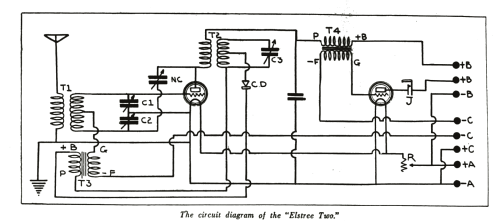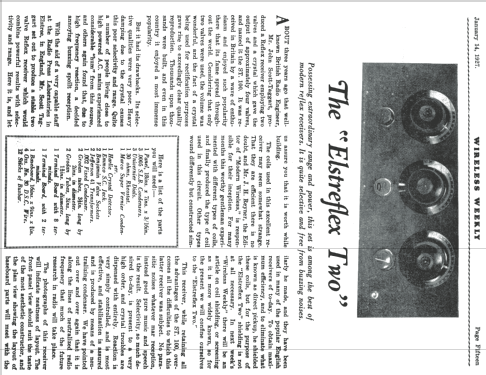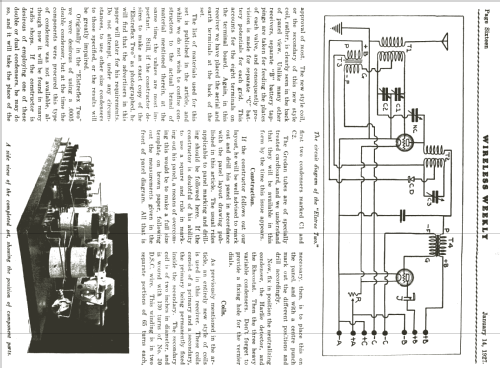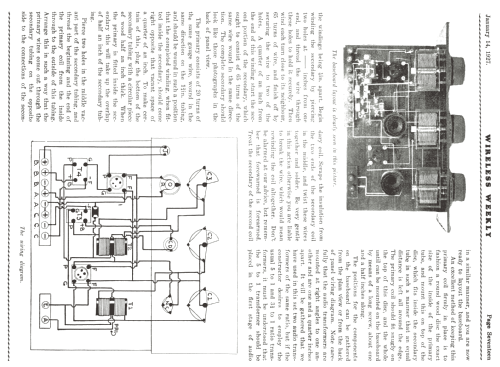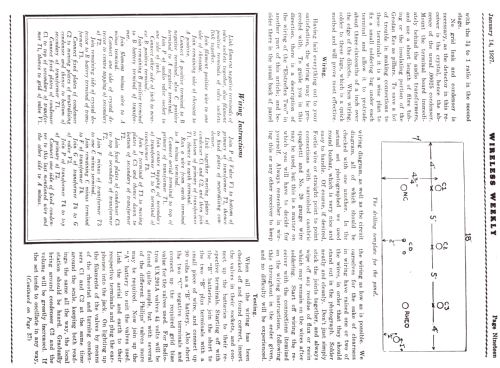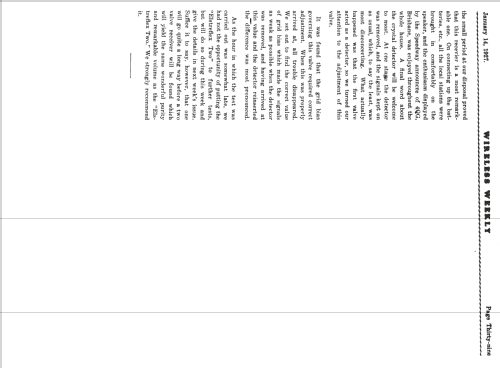Elstreflex Two
Wireless Weekly Magazine, Sydney
- Country
- Australia
- Manufacturer / Brand
- Wireless Weekly Magazine, Sydney
- Year
- 1927
- Category
- Kit (Parts plus instruction) or building instructions only
- Radiomuseum.org ID
- 331931
Click on the schematic thumbnail to request the schematic as a free document.
- Number of Tubes
- 2
- Main principle
- TRF with regeneration
- Wave bands
- Broadcast only (MW).
- Power type and voltage
- Storage and/or dry batteries / 6 & 4½ & 2 x 45 Volt
- Loudspeaker
- - Is a Headphone or Earphone
- Material
- Bakelite, TUBES VISIBLE
- from Radiomuseum.org
- Model: Elstreflex Two - Wireless Weekly Magazine,
- Shape
- Chassis only or for «building in»
- Notes
-
The "Elstreflex Two”, Wireless Weekly’s version of the British Radio Engineer, John Scott-Taggart’s Reflex receiver, ST-100.
In 1923 Scott-Taggart produced a Reflex receiver employing two valves and a crystal which gave the output of approximately four valves and named it the ST-100. It was received in Britain by a wave of enthusiasm and enjoyed such popularity there that its fame spread throughout the world. Considering that only two valves were used, the volume was wonderful, and the fact of a crystal being used for rectification purposes gave rise to exceedingly clear quality reproduction. Thousands upon thousands were built, and even in this country it enjoyed a most immense popularity. But it had its drawbacks. Its selective qualities were very poor. Heavy damping due to the crystal causes this poor selectivity and range. Quite a number of people living close to high powered A.C. mains experienced considerable “hum” from this source, and others again found that, due tohigh frequency reaction, a decided annoying buzzing spoilt reception.
With the aid of a very capable staff at the Radio Press Laboratories in Elstree, in England, Scott Taggart set out to produce a stable two valve Reflex receiver which would combine powerful results with selectivity and range. Here it is and let us assure you that it is worthwhile building.
The coils used in this excellent receiver may seem somewhat strange.That they are efficient there is no doubt, and Mr. J. H. Reyner, the Editor of “Modern Wireless,” is responsible for their inception. For many months this worthy gentleman experimented with different types of coils, and finally produced the type of coil used in this circuit. Other types wound differently have been used in many of the popular English receivers of today. To obtain maximum efficiency, and to eliminate what is known as direct pickup, he shielded these coils, but for the purpose of the “Elstreflex Two” shielding is not at all necessary. In next week’s “Wireless Weekly” there will be an article on coil shielding, or screening as it is more widely known, so for the present we will confine ourselves to the “Elstreflex Two.’’
This receiver, while retaining all the advantages of the ST-100, overcomes all the difficulties to which this latter receiver was subject. No parasitic noises whatever mar reception, instead good pure music and speech is the result. Selectivity, so much desired today, is present to a very high order, and crystal troubles are dispensed with entirely. Reaction is very simply controlled, and is mosteffective, and stabilization is assured and is produced by means of a neutralizing condenser. We have pointed out over and over again that it is along the lines of neutralized radio frequency that much of the future research in radio will take place.
Wireless Weekly January 14, 1927, Page 16.
The cost of parts was £6/6/5 including Harlie Detector but excluding batteries and valves.
- Mentioned in
- Wireless Weekly (Australia) (January 14, 1927, Page 16.)
- Author
- Model page created by Gary Cowans. See "Data change" for further contributors.
- Other Models
-
Here you find 19 models, 13 with images and 19 with schematics for wireless sets etc. In French: TSF for Télégraphie sans fil.
All listed radios etc. from Wireless Weekly Magazine, Sydney
